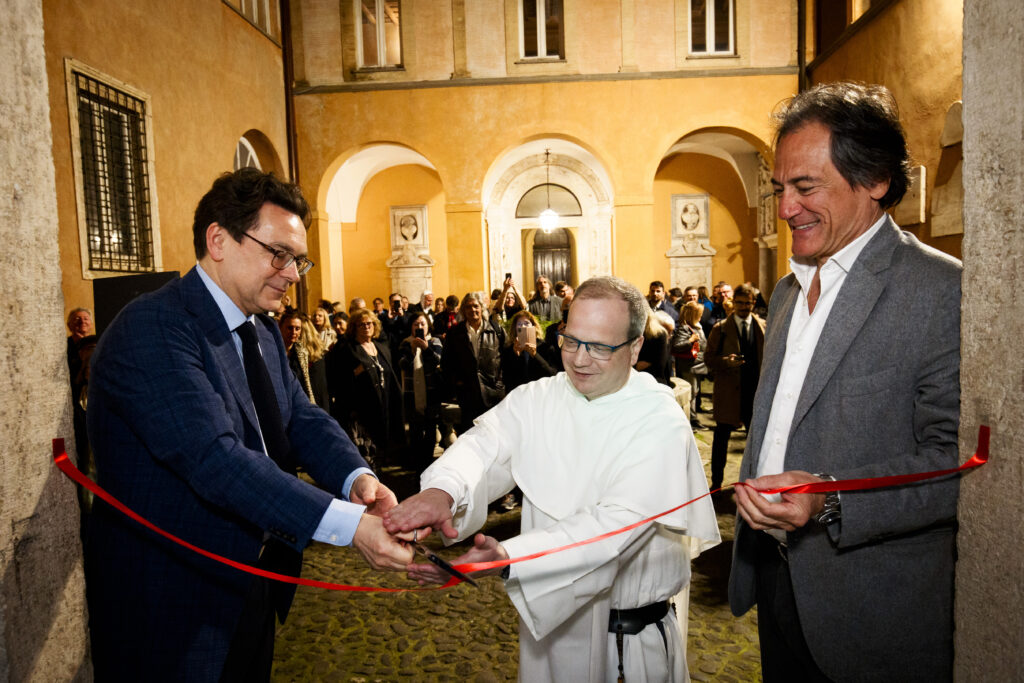
The Annunciation – opening of the exhibition
On the warm evening of March 19, twenty paintings of the Annunciation created by contemporary artists were presented near the Tiber River, in the historic center of the Eternal City. The opening of the exhibition at the San Salvatore in Lauro Museums brought together numerous guests and art lovers. They were greated by the Angelicum Rector Fr. Thomas Joseph White, O.P., and program director of the St. John Paul II Institute of Culture Dr. Dariusz Karłowicz, who curated the exhibition.
The guests were welcomed by Lorenzo Zichichi, the museum’s director who expressed his joy on San Salvatore in Lauro becoming a place of deepening reflection on the perception of beauty. He reminded the names of Umberto Mastroianni and Emilio Greco, 20th century sculptors whose works are kept in the museum and its archives, stressing that the “Let’s paint Catholicism again” project coincides with the museum’s goals, bringing together great artistic talents and inviting them to continue creating Gospel-inspired images. He emphasized the need to continue this path, which in the recent past resulted, among others, in the museum’s long-standing collaboration with Polish sculptor Igor Mitoraj.
Referring to the theme of the exhibition, Zichichi reminded that the history of European painting features various depictions of the Annunciation which are a result of our common European heritage. Despite differences in lifestyle and local culture in different European countries, we all have the same way of looking at sacred art. This is what continues to stimulate creativity and makes our societies richer.
Also speaking at the opening was Angelicum rector Fr. Thomas Joseph White O.P., who thanked Dariusz Karłowicz and the San Salvatore in Lauro Museums for their contribution to the development of the dialogue between contemporary art and sacred art, the Church and faith. He expressed his hope and optimism about reconnecting the riches of theology and contemporary art stressing that the mysteries of the Rosary are not only a great intellectual challenge, but also exceptionally wonderful subjects for artistic expression.
Dariusz Karłowicz, the initiator of the “Let’s paint Catholicism again” project presented the project’s ambitious goals, including the revival of sacred painting and, in a broader perspective, re-establishing a dialogue between the Church and culture.
“If Christianity wants to avoid being put in a museum, we must state this firmly – past art and past culture are just not enough. Copying existing works cannot be our goal. We must create new sacred paintings which use contemporary language and may serve people of the 21st century in prayer and worship” – said Karłowicz.The First Joyful Mystery of the Rosary – the Annunciation – is an event that changed human history forever, mentioned Karłowicz referring to the theme of the exhibition. Just after Mary uttered her fiat, “the Word became flesh.” It was this arch-important event that the painters faced, and we can now admire the fruit of their work within the walls of the Roman gallery.
Karłowicz also strongly emphasized the fact that the “Let’s Paint Catholicism Again” project is possible thanks to the generosity of private entrepreneurs from Poland and a number of committed individuals who are involved in the intellectual and organizational background of the project.
After the speeches, the guests gathered in the museum listened to a short concert by violinist Iga Gałczyńska, who performed three Ave Maria pieces by Bach-Gounod, Franz Schubert and one unknown composer.
Finally, Dariusz Karlowicz, Fr. Thomas Joseph White and Lorenzo Zichichi opened the exhibition for the guests with an official ribbon-cutting ceremony.
See video from the event:
The exhibition is open for visiting from Tuesday to Saturday in the hours: 10 am – 1 pm / 4 pm – 7 pm, until April 13. Admission is free.
Organizers: St. John Paul II Institute of Culture at the Pontifical University of St. Thomas Aquina – Angelicum in Rome, Saint Nicholas Foundation, Museums of San Salvatore in Lauro in Rome.
